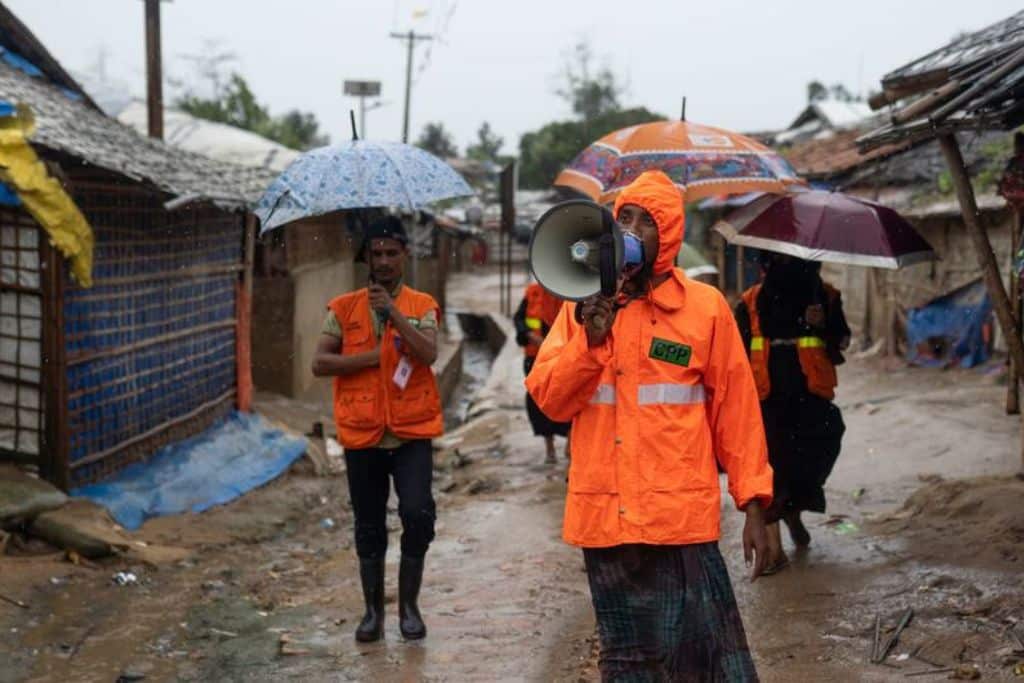Tropical Cyclone Mocha, one of the strongest to ever hit Myanmar with wind gusts of over 200 km/h, is also Earth’s fourth cat-5 storm of 2023.
—
Category-5 tropical cyclone Mocha slammed into northwestern Myanmar and Bangladesh on Sunday, bringing torrential rains and wind gusts of over 200 kilometres per hour (196 mph) that have cut communications to coastal areas and triggered the evacuation of nearly a million people.
Kutupalong, the world’s largest refugee camp located in the Bangladeshi coastal district of Cox’s Bazar and inhabited mostly by Rohingya that fled from ethnic and religious persecution in neighbouring Myanmar, was badly hit, with more than 3,000 shelters damaged and many completely destroyed. Despite the significant damage, authorities say the worst had been avoided.
According to the country’s refugee commissioner, 32 learning centres and 29 mosques were also damaged during the passage of Mocha. Government figures revealed on Sunday night that around 250,000 were in need of food and shelter across the region.
The United Nations Office for the Coordination of Humanitarian Affairs (OCHA) said Cyclone Mocha was one of the strongest to ever hit Myanmar and left a “trail of devastation”. Several people died while hundreds of thousands of Rohingya were left homeless. The country was already dealing with a huge economic and social crisis amid years of conflict and displacement, with six million people in need of relief aid before Mocha hit.
#CycloneMocha has hit an area already facing severe humanitarian needs.
The damage is extensive, exacerbating the needs of vulnerable communities.
Urgent funds are required for a large-scale response in #Myanmar & #Bangladesh. pic.twitter.com/63RMwTX2HD
— UN Humanitarian (@UNOCHA) May 15, 2023
According to OCHA’s latest situation report, as of Monday, “communications with teams on the ground [were] still limited.” The assessment also suggested “significant” damage across the country, particularly in Myanmar’s western state of Rakhine. Military leaders declared the state a natural disaster area, as locals estimated that about 90% of the state capital Sittwe had been destroyed.
Jeff Masters, a meteorologist at Yale Climate Connections, said in a post that, with winds peaking at 281 km/h (175 mph), Mocha became the strongest ever recorded in the North Indian Ocean, along with 2019’s Tropical Cyclone Fani.

Strongest tropical cyclones in the North Indian Ocean. Image: Yale Climate Connections.
Mocha is also Earth’s fourth category-5 storm this year, alongside three Southern Hemisphere storms: Isla in northwest Australia, Kevin in southeast Vanuatu in the South Pacific, and Freddy in Madagascar. The latter set a record for the longest-lived storm, lasting about five weeks, and was rated among the deadliest cyclones to ever hit Africa with nearly 1,500 fatalities.
Tropical cyclones, hurricanes, and typhoons are fuelled by warm water and rapidly warming oceans across the world are increasing their frequency and intensity.
According to the US National Oceanic and Atmospheric Administration (NOAA), the global sea surface temperature hit an all-time high last month since satellite records began, beating the previous record of 21C set in 2016. The jump between early March and the last week of April was almost two-tenths of a degree Celsius (0.36F). Last month was also the fourth-warmest April on record.
As the Northern Hemisphere prepares to enter its peak season for extreme weather events, including hurricanes and typhoons as well as droughts and heatwaves, climate scientists warn that the humanitarian costs will likely be high in coming months.
Featured image: UNICEF/Sultan Mahmud Mukut
You might also like: April’s Record Ocean Warming Spike Could Signal Acceleration of Global Warming, Scientists Say


















